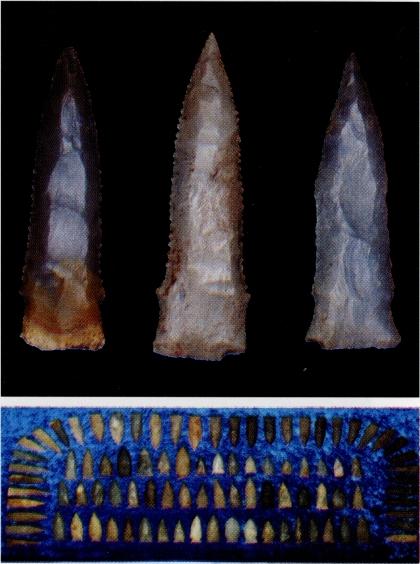by Steven R. Cooper, Editor-in-Chief
Originally Published in the Central States Archaeological Journal, Vol.55, No.3, pg.158
I feel lucky to live by a river that has actually had a point style named after it. This point type was named by James W. Cambron after a local collector, Wayne Crabtree, found numerous examples along this river in Cheatham and Dickson Counties Tennessee. However, the point is not limited to this small area, and I have seen many found in Kentucky along the Cumberland River drainage (Figures 1 and 2). They are also found in Northern Alabama and Mississippi. These are considered to be Transitional Paleo and/or Early Archaic points. One of these points was found associated with a cache of four stemmed Kirk Points in January 1993, helping to accurately date them.
Several years ago, when I first encountered these points, a collector from Smithland, Kentucky, Mark Harris, pointed out how to identify them. He showed me the key is that the point is always steeply beveled on all four sides. However, there are numerous variations in the hafting area and the look of the base. I have seen a few that are highly serrated. Perhaps over time these variations occurred, with the earliest being the examples that have a lanceolate shape. While most are between 2 Y2-3 1/2 inches in length, there are some much larger examples (Figure 3). Most collectors outside of the immediate area of where these are found have rarely seen one.

Fig 1: — A 4″ Harpeth River Point found in Livingston County Kentucky along the Cumberland River by Rick Travelstead. Holland Higgs Collection, Cadiz, Kentucky.


Fig 2: — Harpeth River points found on one site located on a creek in Christian County, Kentucky between the years 1995-2000. The site yielded more than 300 Harpeth River Points. Pictured at bottom are more than 100 of those points. The close-up picture at the top is of three from the bottom grouping. The center point is 3 1/2 inches, and has fine serrations Holland Higgs Collection, Cadiz, Kentucky


Fig 3: — Both sides of a very large Harpeth River point. It’s beautiful orange coloring comes from what is commonly called “river stain”. This results from being immersed in the soft soils of a riverbed. This point was found in November 1996 near Clovis landing in Humphreys County Tennessee. It has large serrations, measures 5 3/4 inches in length and is shown full size.Mike Denniston Collection, Kingston Springs, Tennessee“Used by Permission of the Author”
To learn more about or to join the Central States Archaeological Society, click here:CSASI.org
